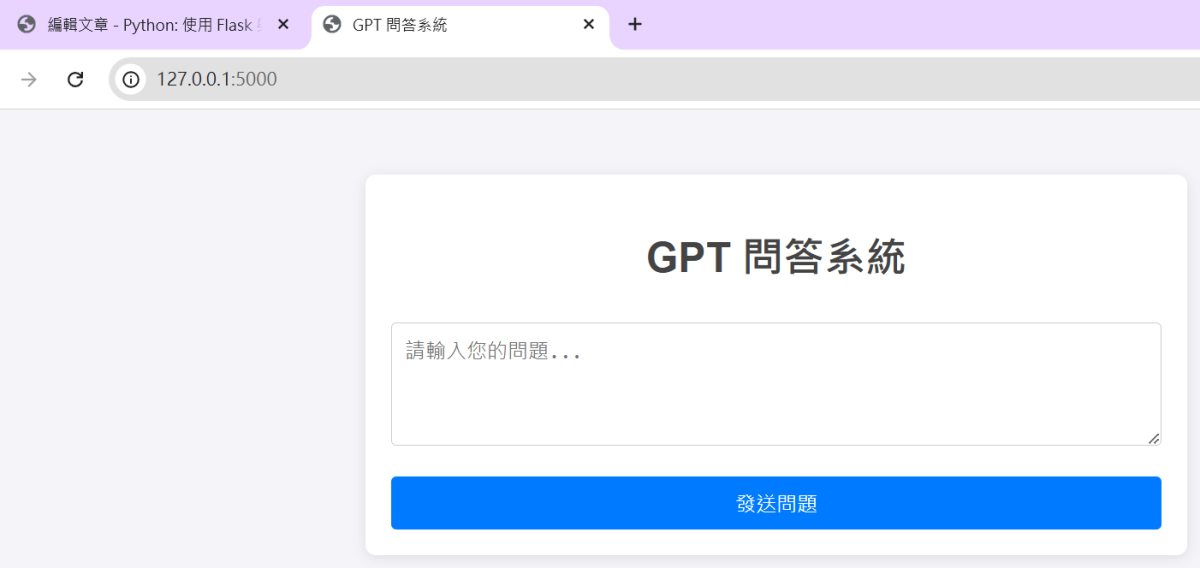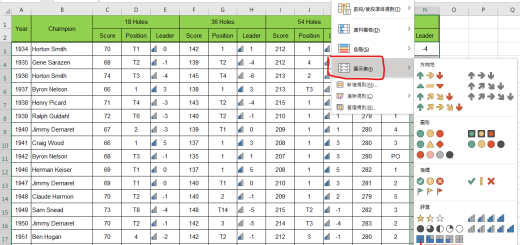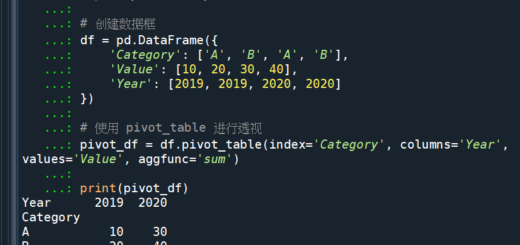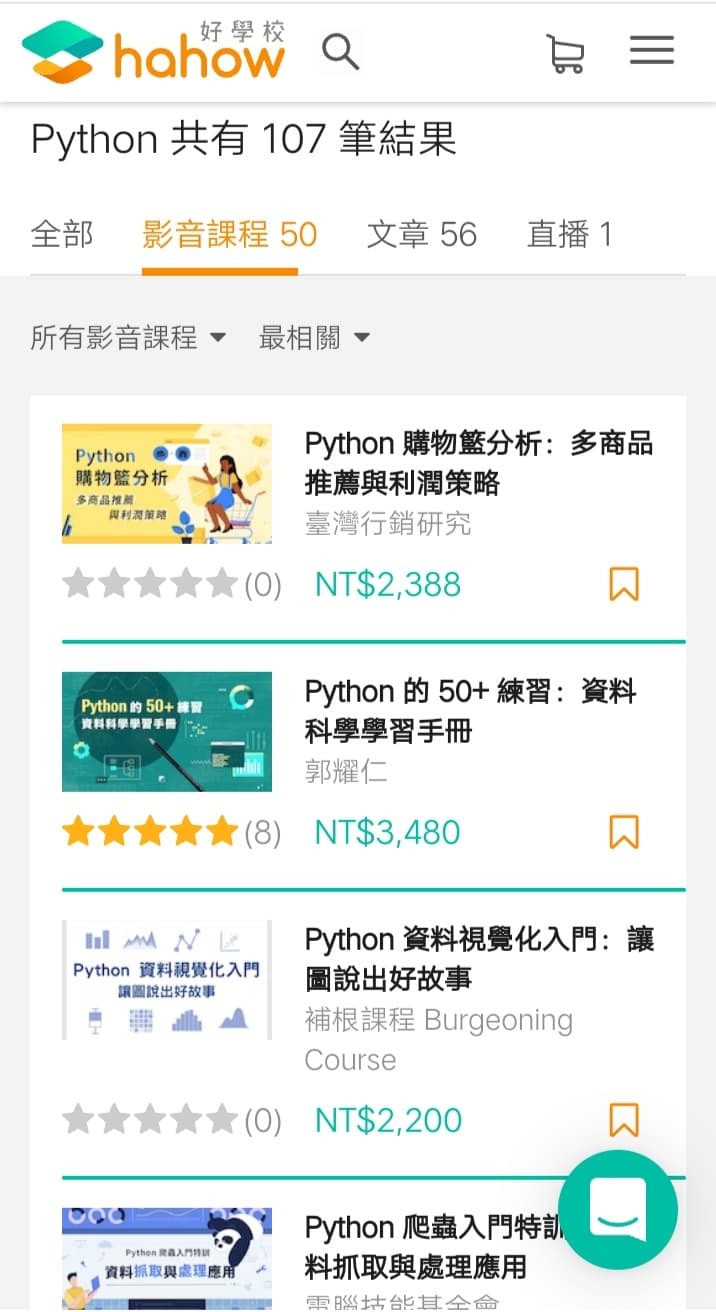code:
import os
import json
from flask import Flask, request, jsonify, render_template
from openai import OpenAI
from typing import List, Dict
import sys
import io
# 將默認編碼設置為 UTF-8
sys.stdout = io.TextIOWrapper(sys.stdout.buffer, encoding="utf-8")
# 設置目錄路徑和文件名
dirname = r"D:\user\Python\GPT\json"
basename_api_key = "api_key.json"
basename_database = "database.json"
path_api_key = os.path.join(dirname, basename_api_key)
path_database = os.path.join(dirname, basename_database)
# 獲取 API Key
def get_api_key(path_api_key=path_api_key):
with open(path_api_key, "r", encoding="UTF-8") as f:
data = json.load(f)
api_key = data["api_key"]
return api_key
api_key = get_api_key(path_api_key=path_api_key)
# 配置 OpenAI 客戶端
client = OpenAI(api_key=api_key)
# 加載 JSON 資料庫
def load_jsonDB(file_path=path_database):
with open(file_path, "r", encoding="utf-8") as f:
database = json.load(f)
return database
# 初始化資料庫
database: List[Dict[str, str]] = load_jsonDB(file_path=path_database)
# 查詢 JSON 資料庫
def query_database(question: str) -> List[Dict[str, str]]:
# 將問題拆分為關鍵詞,並匹配資料庫內容中是否包含關鍵詞
results = [dic for dic in database if any(word in dic["content"].lower() for word in question.lower().split())]
return results
# 初始化 Flask 應用
app = Flask(__name__)
# GPT 問答接口
@app.route("/ask", methods=["POST"])
def ask_gpt():
try:
# 獲取用戶問題
data = request.json # 從用戶的 POST 請求中提取 JSON 數據
user_question = data.get("question", "")
# 查詢 JSON 資料庫
db_results = query_database(user_question)
# 構造 GPT 提示
if db_results:
# 如果資料庫有匹配結果
gpt_prompt = f"資料庫查詢結果:{db_results}\n\n用戶問題:{user_question}\n\n請根據資料庫內容回答:"
else:
# 如果資料庫沒有匹配結果,讓 GPT 自行回答
gpt_prompt = f"用戶問題:{user_question}\n\n資料庫中沒有相關內容,請根據一般知識回答:"
# 向 GPT 發送請求
response = client.chat.completions.create(
model="gpt-4-32k",
messages=[
{"role": "system", "content": "你是專業的問題回答助手,請根據用戶的問題給出準確的回答。"},
{"role": "user", "content": gpt_prompt},
],
)
print("response:\n",response)
# 提取 GPT 的回答
answer = response.choices[0].message.content
print("GPT 回答:", answer)
# 返回 JSON 格式的回答
return jsonify({"answer": answer})
except Exception as e:
# 返回錯誤信息
return jsonify({"error": str(e)}), 500
# 網頁接口
@app.route("/")
def index():
return render_template("index.html") # 加載 templates/index.html 文件
# 啟動 Flask 服務器
if __name__ == "__main__":
app.run(host="0.0.0.0", port=5000, debug=True)執行程式後:

http://127.0.0.1:5000/

在這篇文章中,我們將詳細介紹如何使用 Python 的 Flask 框架和 OpenAI API 建立一個智能問答系統。這個系統能夠根據用戶的問題查詢本地 JSON 資料庫,並結合 OpenAI 的 GPT 模型生成答案。我們會一步步引導您設置環境、編寫代碼,以及如何購買 OpenAI API Key,讓您快速上手開發這樣一個功能強大的應用。
目錄
- 系統功能概述
- 準備工作
- 購買 OpenAI API Key
- 安裝必要的工具與庫
- 程式碼詳細解說與註解
- 啟動與測試
- 結語
1. 系統功能概述
這個智能問答系統的主要功能包括:
- 查詢本地 JSON 資料庫:當用戶輸入問題時,系統會先檢索本地 JSON 文件,嘗試找到和問題相關的內容。
- 結合 GPT 模型生成答案:如果資料庫中有相關內容,系統會將這些內容作為上下文提示 GPT;如果資料庫中沒有匹配的內容,則直接讓 GPT 根據一般知識回答。
- 簡單的 Web 網頁界面:用戶可以通過 Web 瀏覽器輸入問題並查看答案。
2. 準備工作
購買 OpenAI API Key
要使用 OpenAI 提供的 GPT 模型,我們需要獲取一個 API Key。以下是購買和獲取 API Key 的步驟:
- 註冊 OpenAI 帳戶
- 前往 OpenAI 官方網站。
- 如果您還沒有帳戶,點擊「Sign up」進行註冊。
- 購買 API Key
- 登錄帳戶後,點擊右上角的「Manage Account」。
- 選擇「Billing」並設置付款方式(信用卡/PayPal)。
- 根據您的需求選擇一個適合的定價計劃。
- API Keys 頁面:https://platform.openai.com/account/api-keys
- Billing 頁面:https://platform.openai.com/account/billing
- 生成 API Key
- 點擊「API Keys」選項卡。
- 點擊「Create new secret key」生成一個新的 API Key。
- 複製該 Key(注意:這是一次性可見的,請妥善保存)。
- 保存 API Key
將 API Key 保存到一個名為api_key.json的文件中,結構如下:
{
"api_key": "your_openai_api_key_here"
}安裝必要的工具與庫
在開發這個系統之前,請確保您已安裝以下工具和庫:
- 安裝 Python
- 請確保您已安裝 Python 3.8 或更高版本,並將其添加到環境變量中。
- 安裝必要的庫
- 使用以下命令安裝開發所需的庫:
pip install flask openai
若使用anaconda:conda install anaconda::flask
conda install conda-forge::openai
設置目錄結構
- 創建一個目錄結構如下:
GPT/
├── app.py # 主程式
├── json/ # 資料庫與 API Key 文件存放
│ ├── api_key.json
│ ├── database.json
├── templates/ # 前端 HTML 文件存放
│ └── index.htmlindex.html內容:
<!DOCTYPE html>
<html lang="en">
<head>
<meta charset="UTF-8">
<meta name="viewport" content="width=device-width, initial-scale=1.0">
<title>GPT 問答系統</title>
<style>
body {
font-family: Arial, sans-serif;
margin: 0;
padding: 0;
background-color: #f4f4f9;
color: #333;
}
.container {
max-width: 600px;
margin: 50px auto;
padding: 20px;
background: #fff;
border-radius: 8px;
box-shadow: 0 2px 10px rgba(0, 0, 0, 0.1);
}
h1 {
text-align: center;
color: #444;
}
textarea, input {
width: 100%;
margin-top: 10px;
padding: 10px;
font-size: 16px;
border: 1px solid #ccc;
border-radius: 4px;
box-sizing: border-box;
}
button {
margin-top: 20px;
width: 100%;
padding: 10px;
background-color: #007BFF;
color: white;
border: none;
border-radius: 4px;
font-size: 16px;
cursor: pointer;
}
button:hover {
background-color: #0056b3;
}
.response {
margin-top: 20px;
padding: 15px;
background-color: #f8f9fa;
border: 1px solid #ddd;
border-radius: 4px;
font-size: 16px;
}
</style>
</head>
<body>
<div class="container">
<h1>GPT 問答系統</h1>
<textarea id="question" rows="4" placeholder="請輸入您的問題..."></textarea>
<button onclick="askGPT()">發送問題</button>
<div id="response" class="response" style="display: none;"></div>
</div>
<script>
async function askGPT() {
const question = document.getElementById("question").value;
const responseDiv = document.getElementById("response");
if (!question.trim()) {
responseDiv.style.display = "block";
responseDiv.innerText = "請輸入問題!";
return;
}
responseDiv.style.display = "none";
responseDiv.innerText = "";
try {
const response = await fetch("/ask", {
method: "POST",
headers: {
"Content-Type": "application/json"
},
body: JSON.stringify({ question })
});
const data = await response.json();
if (data.answer) {
responseDiv.style.display = "block";
responseDiv.innerText = "GPT 的回答:\n" + data.answer;
} else if (data.error) {
responseDiv.style.display = "block";
responseDiv.innerText = "錯誤:\n" + data.error;
}
} catch (error) {
responseDiv.style.display = "block";
responseDiv.innerText = "請求失敗,請檢查伺服器是否正常運行。\n" + error;
}
}
</script>
</body>
</html>3. 程式碼詳細解說與註解
以下是完整程式碼的分段講解。
1. 引入必要的模組
import os
import json
from flask import Flask, request, jsonify, render_template
from openai import OpenAI
from typing import List, Dict
import sys
import ioos 和 json:用於處理文件操作以及 JSON 格式數據。 flask:用於建立 Web 應用。 openai:用於與 OpenAI API 交互。 typing:用於指定數據類型。 sys 和 io:用於解決 Python 默認編碼問題。
設置 UTF-8 編碼
# 將默認編碼設置為 UTF-8
sys.stdout = io.TextIOWrapper(sys.stdout.buffer, encoding="utf-8")- 解決 Python 在輸出中文時可能遇到的編碼問題。
3. 設置文件路徑
dirname = r"D:\user\Python\GPT\json"
basename_api_key = "api_key.json"
basename_database = "database.json"
path_api_key = os.path.join(dirname, basename_api_key)
path_database = os.path.join(dirname, basename_database)指定存放 API Key 和資料庫文件的路徑。
獲取 API Key
def get_api_key(path_api_key=path_api_key):
with open(path_api_key, "r", encoding="UTF-8") as f:
data = json.load(f)
api_key = data["api_key"]
return api_key
api_key = get_api_key(path_api_key=path_api_key)- 從
api_key.json文件中讀取 API Key。
5. 配置 OpenAI 客戶端
client = OpenAI(api_key=api_key)
- 使用獲取的 API Key 配置 OpenAI 客戶端。
6. 加載 JSON 資料庫
def load_jsonDB(file_path=path_database):
with open(file_path, "r", encoding="utf-8") as f:
database = json.load(f)
return database
database: List[Dict[str, str]] = load_jsonDB(file_path=path_database)將本地 JSON 資料庫加載到內存中。 資料庫文件結構示例:
[
{"content": "Flask 是一個 Python 的 Web 框架。"},
{"content": "GPT 是一種基於 Transformer 的大型語言模型。"},
{"content": "JSON Line 是一種每行為一個 JSON 對象的文件格式。"}
]7. 查詢 JSON 資料庫
def query_database(question: str) -> List[Dict[str, str]]:
results = [dic for dic in database if any(word in dic["content"].lower() for word in question.lower().split())]
return results根據用戶問題中的關鍵詞查詢資料庫,返回匹配的結果。
8. 啟動 Flask 應用
app = Flask(__name__)
- 初始化 Flask 應用。
9. GPT 問答接口
@app.route("/ask", methods=["POST"])
def ask_gpt():
try:
data = request.json
user_question = data.get("question", "")
db_results = query_database(user_question)
if db_results:
gpt_prompt = f"資料庫查詢結果:{db_results}\n\n用戶問題:{user_question}\n\n請根據資料庫內容回答:"
else:
gpt_prompt = f"用戶問題:{user_question}\n\n資料庫中沒有相關內容,請根據一般知識回答:"
response = client.chat.completions.create(
model="gpt-4-32k",
messages=[
{"role": "system", "content": "你是專業的問題回答助手,請根據用戶的問題給出準確的回答。"},
{"role": "user", "content": gpt_prompt},
],
)
answer = response.choices[0].message.content
return jsonify({"answer": answer})
except Exception as e:
return jsonify({"error": str(e)}), 500- 該接口處理用戶問題,與 OpenAI API 交互生成答案。
10. 網頁接口
@app.route("/")
def index():
return render_template("index.html")- 加載前端 HTML 文件,提供簡單的用戶界面。
11. 啟動服務器
if __name__ == "__main__":
app.run(host="0.0.0.0", port=5000, debug=True)- 啟動 Flask 開發服務器。
4. 啟動與測試
- 啟動 Flask 應用:
python app.py
2. 打開瀏覽器訪問
http://localhost:5000
測試問答功能。
5. 結語
恭喜!您已成功搭建了一個基於 Flask 的智能問答系統,
並結合 OpenAI 的 GPT 模型處理用戶的問題。
如果您有更多功能需求
(如增加用戶身份驗證、支持多語言等),
可以基於此系統進一步擴展!
推薦hahow線上學習python: https://igrape.net/30afN




![Python: 資料格式如 List[dict],如何快速將SN加入每一個dict中,以利Excel輸出?如何解包dict? **dict ; 將List[dict]的資料轉為pandas.DataFrame 長什麼樣子? Python: 資料格式如 List[dict],如何快速將SN加入每一個dict中,以利Excel輸出?如何解包dict? **dict ; 將List[dict]的資料轉為pandas.DataFrame 長什麼樣子?](https://i1.wp.com/savingking.com.tw/wp-content/uploads/2024/02/20240208093926_0.png?quality=90&zoom=2&ssl=1&resize=350%2C233)








近期留言